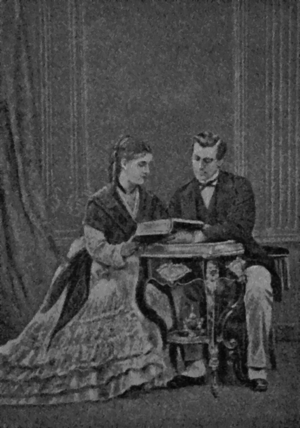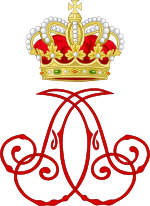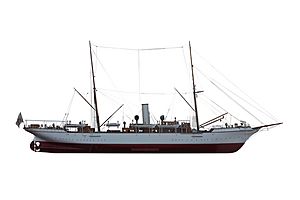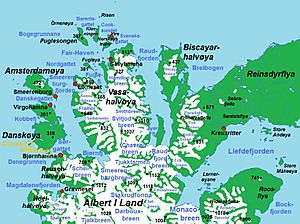Albert I, Prince of Monaco facts for kids
Quick facts for kids Albert I |
|
|---|---|
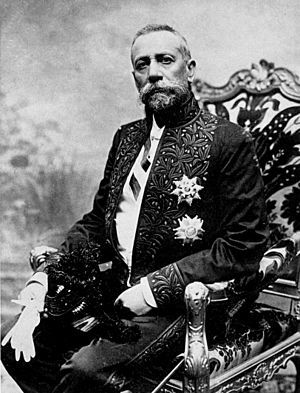
Albert I, c. 1910
|
|
| Prince of Monaco | |
| Reign | 10 September 1889 – 26 June 1922 |
| Predecessor | Charles III |
| Successor | Louis II |
| Born | 13 November 1848 Paris, France |
| Died | 26 June 1922 (aged 73) Paris, France |
| Burial | Saint Nicholas Cathedral, Monaco |
| Spouse |
|
| Issue | Louis II, Prince of Monaco |
| House | Grimaldi |
| Father | Charles III, Prince of Monaco |
| Mother | Antoinette de Mérode |
Albert I (born Albert Honoré Charles Grimaldi; 13 November 1848 – 26 June 1922) was the Prince of Monaco from 1889 until his death. He spent much of his life studying the ocean, exploring, and doing scientific research. Besides his expeditions, Prince Albert I also made important changes to Monaco's government, economy, and society. He gave the principality a constitution in 1911.
Contents
Early Life of Prince Albert I
Albert I was born on 13 November 1848 in Paris, France. His father was Prince Charles III. His mother was Countess Antoinette de Mérode-Westerloo. She was a noblewoman from Belgium.
When he was young, Prince Albert served in the Spanish Navy as a navigator. During the Franco-Prussian War, he joined the French Navy. He was given the Legion of Honour for his service.
Prince Albert was very interested in oceanography, which is the study of the ocean. He also loved learning about how humans first appeared. In Paris, he started the "Institute for Human Paleontology". This institute was in charge of many important archeological digs. A famous discovery, the "Grimaldi Man", was found in a cave and named in his honor. Albert's scientific work was recognized around the world. In 1909, the British Academy of Science made him a member.
Prince Albert I's First Marriage
On 21 September 1869, Prince Albert married Lady Mary Victoria Hamilton. The wedding took place at the Château de Marchais in Champagne. This castle is still owned by the Grimaldi family today. Lady Mary was from Lanarkshire, Scotland. Her father was the 11th Duke of Hamilton.
Albert and Mary met in August 1869 at a ball in France. Their marriage was arranged by Albert's grandmother, Caroline. Caroline had hoped Albert would marry Princess Mary Adelaide of Cambridge. She was a cousin of Queen Victoria. However, this plan did not work out.
Mary was related to the French Imperial family. Her grandmother was Stéphanie de Beauharnais, who was Emperor Napoléon I's adopted daughter. The Hamilton family knew that Monaco was a small country. But they were impressed that it was an independent principality.
Within a year of their marriage, their only child, Louis, was born. However, Mary did not like living in Monaco. She was used to the hills of Scotland and did not enjoy the Mediterranean area. While Albert was fighting in the Franco-Prussian War, she left Monaco for good. The couple later divorced. Their marriage was annulled by the Church on 3 January 1880. A special rule was made by the Vatican so that Louis would still be considered legitimate by the Church. The civil divorce happened on 28 July 1880. Later that year, Mary remarried in Italy.
Becoming Prince and Second Marriage

On 10 September 1889, Albert became the Prince of Monaco. This happened after his father passed away. In the same year, on 30 October, he married Marie Alice Heine in Paris. Alice was an American woman from New Orleans, Louisiana. She had been married before to the Duc de Richelieu, but he had passed away.
Alice brought good business skills to the marriage. She helped Monaco become financially stable. She also worked to make Monaco a famous cultural center in Europe. Thanks to her, Monaco had a great opera, theater, and ballet. These were directed by the famous Russian impresario Serge Diaghilev.
Even though their marriage started well, Prince Albert and Princess Alice separated in 1902. They did not have any children together. They never divorced.
Later Life and Reforms
In March 1910, there were large protests against Prince Albert's rule in Monaco. The people of Monaco wanted a constitution and a parliament. They wanted to limit the power of the absolute monarch. They were unhappy about France's strong influence on Monaco's politics and economy. There was also a lot of unemployment. Monaco did not have many factories or farms. Also, citizens were not allowed to work in the casinos.
On 5 January 1911, Prince Albert I gave Monaco a constitution. However, this document did not truly reduce his power. He suspended it soon after World War I began. Also in 1911, Prince Albert created the Monte Carlo Rally. This was a car race designed to attract tourists to Monaco and its famous Casino.
Despite his military background, Prince Albert became a supporter of peace. He started the International Institute of Peace in Monaco. This place was meant to help solve conflicts peacefully through discussion. Before World War I, Prince Albert tried many times to convince Kaiser Wilhelm II of Germany not to go to war.
When the war started, Prince Albert still tried to help. He even wrote to the Kaiser himself. He wanted to reduce the damage caused by a German general. Thanks to his help, some French villages were saved from destruction. Monaco officially stayed neutral during the "Great War". However, it provided hospitals and care centers for Allied soldiers. Prince Albert's only son, Louis, also served in the war.
Albert I passed away on 26 June 1922 in Paris, France. His son, Louis II, became the next Prince.
Oceanography and Science
Prince Albert I of Monaco spent a lot of his life studying the sea and oceans. He was very passionate about oceanography. When he was 22 years old, he began his career in this new science. He understood how important the connection between sea creatures and their environment was. He invented many tools and methods for measuring and exploring the ocean.
Albert I was a key figure in creating the science of oceanography. In 1906, he founded the Institut océanographique. This foundation has two main buildings. One is the Oceanographic Institute of Paris, now called Ocean House. The other is the famous Oceanographic Museum of Monaco. This museum includes an aquarium, a museum, and a library. It also has research facilities in Paris.
He owned four research yachts, each more impressive than the last. These were named Hirondelle, Princesse Alice, Princesse Alice II, and Hirondelle II. He traveled all over the Mediterranean Sea with leading marine scientists. They conducted many oceanographic studies and created maps. In 1896, he discovered the Princess Alice Bank during a survey near the Azores.
From a young age, Prince Albert I was very interested in the polar regions. Between 1898 and 1907, he made four scientific trips to Svalbard on his yacht, Princesse Alice. Today, a part of Spitsbergen is named Albert I Land in his honor.
His first trip in 1898 focused on studying the ocean and animals. The goal was to add to the collections of the Oceanographic Museum of Monaco. On his second trip in 1899, he focused on the water and land features of Raudfjorden. This area is on the north-western tip of Spitsbergen. He published a map of this area.
On his third trip in 1906, he also studied the weather. He supported other expeditions too. One was by the Scotsman William Bruce to Prins Karls Forland. Another was by the Norwegian Gunnar Isachsen to northwestern Spitsbergen. Albert's funding of Isachsen's trip led to regular Norwegian scientific expeditions to Svalbard. It also led to the creation of the Norwegian Polar Institute in 1928.
The Prince's fourth expedition in 1907 aimed to finish the work from the previous summer. Prince Albert also helped many Arctic and Antarctic explorers. He gave them money, gifts, or lent them oceanographic tools. In the same year, he helped found the Friends of the French National Museum of Natural History Society. In 1909, he joined the Société de Géographie and the British Academy.
In 1910, the Prince was the main founder of the Institute of Human Paleontology in Paris. This institute is near the Jardin des plantes, where the French National Museum of Natural History is located. Finally, he cared deeply about protecting the environment, especially in Svalbard.
In 1918, the US National Academy of Sciences gave Prince Albert the Alexander Agassiz Medal. This was for his great achievements. The Explorers Club made Albert I an Honorary Member in 1921. He also received the Cullum Geographical Medal from the American Geographical Society. The Prince Albert I Medal was created in his honor. It is given for achievements in the physical and chemical sciences of the oceans.
Other Interests
Philately (Stamp Collecting)
Albert I built a collection of postage stamps. This collection was later continued by Louis II. It is now part of the postal museum that Rainier III created in 1950.
Numismatics (Coins)
In 2022, Albert I was featured on a special €2 coin. This coin was issued by the Principality of Monaco to remember him.
Honours
- Decorations
 Monaco: Grand Master of the Order of St. Charles
Monaco: Grand Master of the Order of St. Charles Austria-Hungary: Decoration of Honour for Arts and Sciences, 1912
Austria-Hungary: Decoration of Honour for Arts and Sciences, 1912 Baden: Grand Cross of the Military Karl-Friedrich Merit Order
Baden: Grand Cross of the Military Karl-Friedrich Merit Order Kingdom of Bavaria: Knight of St. Hubert, 1900
Kingdom of Bavaria: Knight of St. Hubert, 1900 Empire of Brazil: Grand Cross of the Order of the Rose, 21 August 1888
Empire of Brazil: Grand Cross of the Order of the Rose, 21 August 1888 France:
France:
- Grand Cross of the Legion of Honour
- Commemoration Medal of the 1870–1871 War
 Kingdom of Italy: Knight of the Annunciation, with Collar, 25 April 1910
Kingdom of Italy: Knight of the Annunciation, with Collar, 25 April 1910 Persia: Order of the Lion and the Sun, 1st Class, 14 January 1915
Persia: Order of the Lion and the Sun, 1st Class, 14 January 1915 Kingdom of Prussia: Knight of the Black Eagle, with Collar
Kingdom of Prussia: Knight of the Black Eagle, with Collar
 Sweden-Norway:
Sweden-Norway:
- Grand Cross of St. Olav, with Collar, 30 March 1875
- Knight of the Seraphim, with Collar, 17 June 1894
 United States:
United States:
- Medal of Alexander Agassiz, 1918
- Medal of Cullum Geography, 1921
 Württemberg: Grand Cross of the Württemberg Crown, 1880
Württemberg: Grand Cross of the Württemberg Crown, 1880 Spain:
Spain:
- Grand Cross of the Order of Charles III, 27 January 1878
- Grand Cross of Naval Merit, with White Decoration, 1886
Images for kids
See also
 In Spanish: Alberto I de Mónaco para niños
In Spanish: Alberto I de Mónaco para niños


